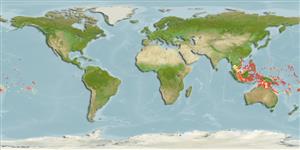Common names from other countries
分类 / Names
俗名 | 同种异名 | Catalog of Fishes(属, 种) | ITIS | CoL | WoRMS | Cloffa
Environment: milieu / climate zone / depth range / distribution range
生态学
海洋 礁区鱼类; 深度上下限 0 - 50 m (Ref. 90102), usually 0 - 15 m (Ref. 90102). 熱帶; 19°N - 24°S
Pacific Ocean: Philippines to the Society Islands, south to New Caledonia. Replaced in the western Indian Ocean by Photoblepharon steinitzi (Ref. 37816).
太平洋: 菲律賓到社會群島, 南至新加勒多尼亞。 在 Photoblepharon steinitzi 的西印度洋取代了。 (參考文獻 37816)
大小 / 重量 / 年龄
Maturity: Lm ? range ? - ? cm
Max length : 12.0 cm TL 雄鱼/尚未辨别雌雄; (Ref. 9710)
背棘 (总数) : 2 - 3; 背的软条 (总数) : 16 - 20; 臀棘: 2; 臀鳍软条: 13 - 15.
Occurs along seaward reefs near or along steep drop-offs with caves (Ref. 9710). In some areas it may approach the surface (Ref. 9710). Usually feeds in large groups away from the reefs at night. Well hidden in caves during the day and rarely seen; often observed at 10-30 m at night (Ref. 48635).
靠近沿着临海礁石生存或者用洞穴沿着陡峭的海峭壁。 (参考文献 9710) 在一些地区,它可能接近表面。 (参考文献 9710) 通常成群觅食远离礁在晚上。 藏在洞穴中在白天期间而且很少地见到。 通常在晚上被观察到。 (参考文献 48635)
Life cycle and mating behavior
Maturities | 繁殖 | Spawnings | Egg(s) | Fecundities | 仔鱼
太平洋: 菲律賓到社會群島, 南至新加勒多尼亞。 在 Photoblepharon steinitzi 的西印度洋取代了。 (參考文獻 37816)
McCosker, J.E. and R.H. Rosenblatt, 1987. Notes on the biology, taxonomy, and distribution of flashlight fishes (Beryciformes: Anomalopidae). Jap. J. Ichthyol. 34(2):157-164. (Ref. 5004)
CITES (Ref. 128078)
Not Evaluated
人类利用
渔业: 没有兴趣; 水族馆: 商业性
工具
特别资料
下载 XML
网络资源
Estimates based on models
Preferred temperature (Ref.
115969): 26.2 - 29.3, mean 28.6 (based on 1756 cells).
Phylogenetic diversity index (Ref.
82804): PD
50 = 0.7520 [Uniqueness, from 0.5 = low to 2.0 = high].
Bayesian length-weight: a=0.01122 (0.00514 - 0.02450), b=3.04 (2.87 - 3.21), in cm Total Length, based on all LWR estimates for this body shape (Ref.
93245).
营养阶层 (Ref.
69278): 3.5 ±0.5 se; based on size and trophs of closest relatives
Fishing Vulnerability (Ref.
59153): Low vulnerability (10 of 100).
